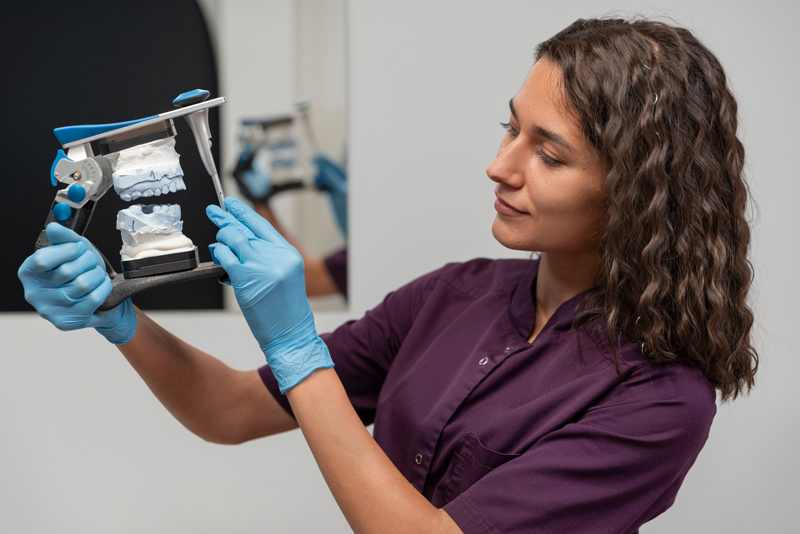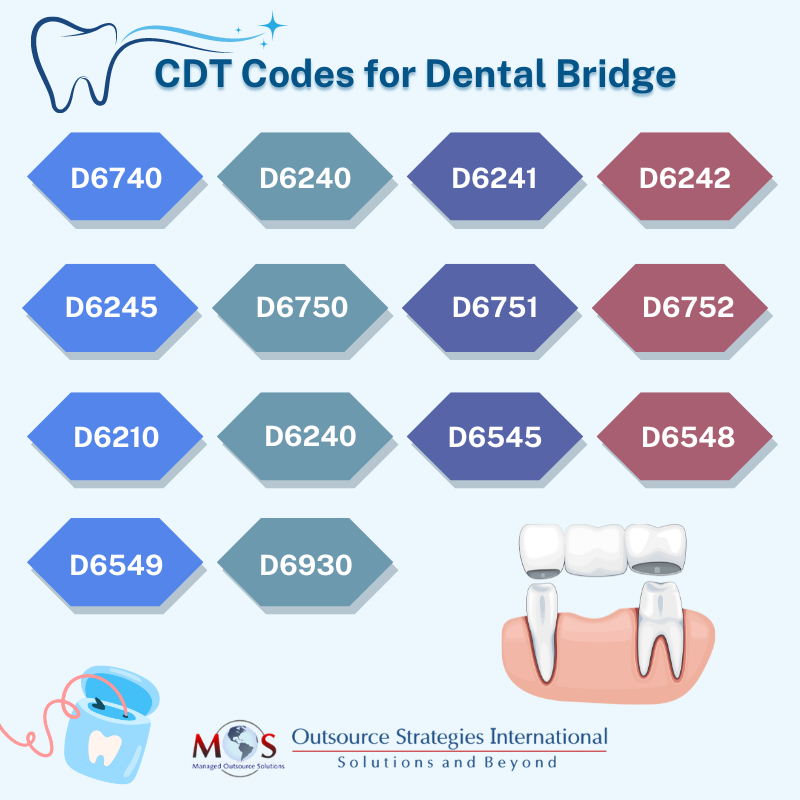Dental bridge is a custom-made fixed appliance solution for connecting the gap between teeth. It is a popular dental restoration procedure for filling one or more missing teeth on either side of the gap. The structure of this prosthetic device consists of abutments, which serve as anchor points capped by the dental crowns attached to the artificial teeth, also known as pontics, on either side of the space. If only one tooth is lost, then the arrangement of the dental bridge is called the three-unit bridge. The bridges are usually constructed based on the dental impression of the patient from various materials such as metal, ceramics, zirconium and composites.
Dental bridges replace the functionality and aesthetics of missing teeth along with a long-lasting natural appearance that preserves tooth alignment. To determine if a patient requires a dental bridge, an oral examination along with dental x-rays or CBCT scan is taken to evaluate the evidence for the need of dental prosthetic. The price of a dental bridge typically ranges from $1,500 to $5,000, influenced by several factors including the number of teeth to be replaced, material used, complexity, and location.
The cost of dental bridge procedure is broken down into various steps such as initial consultation, x-ray taken, dental bridge installation, and follow-up visits for additional procedures. Therefore, it is an expensive investment that should be navigated with the right strategies for long-term oral health. For this procedure, dental insurance coverage is offered, so claim submission is crucial. Dental claim submission is a complex process; dentists can rely on dental billing services to submit claims on time with accurate codes.
Let’s look at the different types of dental bridges and the applicable CDT codes.
Different Types of Dental Bridges
Dentists mainly offer four options for dental bridges depending on individual cases. The four dental bridge options are:
- Traditional Dental Bridge
Traditional fixed bridges are composed of two parts:
- Dental crowns on either side of the missing gap with a filler tooth or pontic, in between to replace the lost tooth.
- A connecting fixture known as abutment teeth, which is the natural teeth, present adjacent to the side of the gap into which the dental crown is securely implanted.
This is the most popular and commonly used type of dental bridge and made from either metal, porcelain fused to metal or zirconia restoration. This can be used when you have a gap created by missing a natural tooth. It is sturdy and requires healthy teeth for support; however, due to its longevity, strength and natural appearance, it is slightly more expensive than the other options.
- Cantilever Dental Bridge
Cantilever dental bridge is similar to a traditional bridge with a slight deviation in structure as it is used when the adjacent teeth are present only on one side of the gap. The single crown on one end is then placed over the abutment tooth and the pontic extends across the gap. Due to its instability, cantilever bridge is not used as frequently as other types but they’re suitable in certain clinical situations when the patient has natural teeth only on one side of the gap. It is recommended that this type be utilized on the front side of the mouth and not on the back as it may cause strain on the single tooth. If this category of bridge is placed safely, then it is considered an effective cost and time-saving option.
- Maryland Bonded Bridge
Maryland bonded bridge, also known as the resin-bonded bridge, has a structure that is identical to the traditional bridge and is commonly used to replace the front teeth. It is constructed of porcelain fused to metal teeth supported by metal framework. The pontic with metal or porcelain wings is bonded to the back of the adjacent healthy teeth to hold the bridge in place. The Maryland Bridge is a cost-effective alternative when no suitable abutment teeth exist. It doesn’t require reshaping, or cause damage to adjacent teeth and is easily removable. However, this type often requires repair as it is dependent upon the strength of the metal framework and may cause discoloration.
- Implant-supported Bridge
The Implant-supported Bridge is similar to the classic traditional bridge. However, unlike the latter option, this type is anchored in place by dental implants as opposed to crowns or framework. Dental implants are small artificial titanium or ceramic posts that are surgically placed into the patient’s jaw line to support a replaced tooth by acting as an artificial root that holds the bridge in position. The dental implants must be inserted and fully integrated with the jaw line before a bridge can be attached to it. This process may take from three to six months to complete.
An advantage of this type is that it doesn’t require adjacent teeth and can be used when there are multiple missing teeth. This bridge can be thought of as a hybrid of implants and dental bridge since the design is akin to regular bridge but with the functionality of an implant. The Implant-Supported Bridge has other advantages including stability, durability, bone preservation, and overall improved oral health. The stages for the Implant-Supported Bridge procedure are:
- Check for adequate bone density, conduct bone grafting procedure if necessary
- Dental implant surgery is conducted to place implants into the jaw line
- Healing period of 3-6 months, osseointegration is allowed
- Dental impressions are taken, abutments are placed
- Personalized implant-supported bridge is securely fixed
Let our experienced dental specialists handle your dental billing process with efficiency.
CDT Codes for Dental Bridge
When it comes to medical documentation, accurate medical codes have to be used on the medical claims submitted to health insurers. Let’s check what the CDT codes for dental bridges are.
D6245 Pontic, porcelain/ceramic (bridge units)
D6740 Retainer Crown – Porcelain/Ceramic With this dental procedure code, the prosthetic crown fitted over the tooth is made of porcelain or ceramic.
D6240 Pontic, porcelain fused to precious/high noble metal (bridge units)
D6241 Pontic, porcelain fused to predominantly base metal/non-precious metal (bridge units)
D6242 Pontic, porcelain fused to semi-precious/noble metal (bridge units)
D6750 Crown, porcelain fused to precious/high noble metal (bridge units)
D6751 Crown, porcelain fused to predominantly base metal/non-precious metal (bridge units)
D6752 Crown, porcelain fused to semi-precious/noble metal (bridge units)
D6210 Pontic for Maryland bridge, cast metal, precious/high noble metal
D6240 Pontic for Maryland bridge, porcelain fused to precious/high noble metal
D6245 Pontic for Maryland bridge, porcelain/ceramic
D6545 Wing retainer, cast metal for bonded fixed prosthesis
D6548 Wing retainer, porcelain/ceramic for bonded fixed prosthesis
D6549 Wing retainer, Composite or resin
D6245 Pontic, porcelain/ceramic (bridge units)
D6075 Implant supported retainer for ceramic FPD -A ceramic retainer for a fixed partial denture that gains retention, support and stability from an implant; may be screw retained or cemented.
D6076 Implant supported retainer for porcelain fused to metal FPD (titanium, titanium alloy, or high noble metal) -A metal-ceramic retainer for a fixed partial denture that gains retention, support and stability from an implant; may be screw retained or cemented.
D6077 Implant supported retainer for cast metal FPD (titanium, titanium alloy, or high noble metal) -A cast metal retainer for a fixed partial denture that gains retention, support and stability from an implant; may be screw retained or cemented.
D6791 Retainer Crown – Full Cast, Predominantly Base Metal Using this dental procedure code, the prosthetic crown is constructed predominantly of base metal and covers the entire remaining portion of the tooth.
D6790 Retainer Crown – Full Cast High Noble Metal This procedure code is used for a prosthetic crown that is constructed of high noble metal and covers the remaining portion of tooth.
Dental Recement Bridge
The installed dental bridge might sometimes detach or get damaged due to many reasons. This can be corrected using the process of bridge recement. For drafting claim documents, the CDT code used for dental bridge recement is D6930.
D6930 recements or rebonds fixed partial denture
Accurate, thorough documentation is the foundation of successful dental coding, billing, claim submission and processing. Dental claim processing differs from that of standard medical claims since they require separate form submission. So, dental billing professionals with years of experience and expertise are essential as even a simple error could result in claim denials. Any errors or discrepancies such as incomplete or incorrect demographic information of patients, error in verifying the eligibility and coverage of insurance, errors in coding, not filing claims on time, submitting reimbursement without sufficient supporting documents and so on would result in denial of claims. In addition, correcting these mistakes and resubmission would be costly and time-consuming.
The best option to draft accurate claim submission documents for an efficient and smooth dental billing process is to join hands with a reliable dental billing company. An experienced dental insurance verification service would provide comprehensive support including coding, billing and more with the support from experts and help to maintain a financially sound practice.





